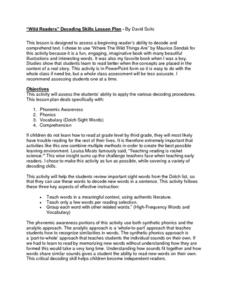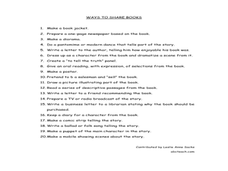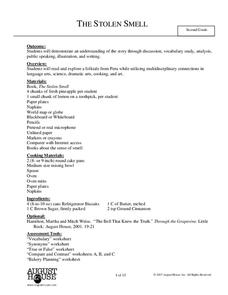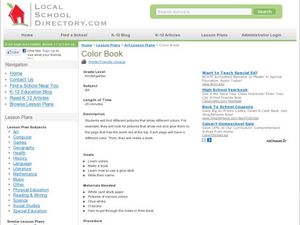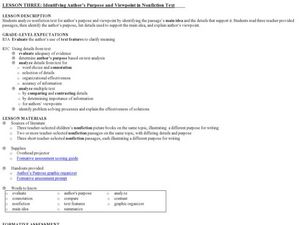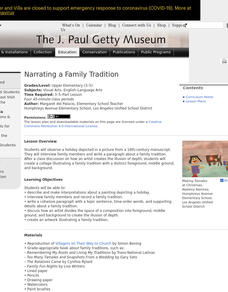David Suits
“Wild Readers” Decoding Skills Lesson Plan
Set young readers on the path toward fluency with this phonemic awareness resource. Based on the award-winning children's book, Where the Wild Things Are, this lesson allows beginning readers to practice isolating...
Curated OER
Rainforest Animal Illustrations
Fourth graders discover what is meant by the term endangered species. After reading a book, they use a document camera to view pictures of each endangered species mentioned. In groups, they are assigned one animal by their teacher and...
Curated OER
Ways to Share Books
In this book report idea sheet, students are given a list of 20 possibilities for creating a non-traditional book report (e.g., making a diorama; making a poster).
Curated OER
Characteristics of a Good Citizen
First graders examine characteristics that good citizens need. In this civic virtues lesson, 1st graders discuss people they know who are heroes or good citizens. Students name three qualities they believe heroes need. Students create a...
Curated OER
A Picture is Worth a Thousand Words - The Caldecott Award
Young scholars engage in a variety of activities as they study illustrators, how illustrations enhance a studenT book, and the Caldecott Award. They write a report about their favorite illustrator.
Curated OER
The Stolen Smell
Second graders read the story The Stolen Smell and participate in many language arts based activity connected to the story. They participate in discussions, vocabulary work, analyzing the story, public speaking, illustrating pictures,...
Open Oregon Educational Resources
Manufacturing Processes 4-5
No need to manufacture an excuse for learning about manufacturing. Scholar use an eBook to study manufacturing processes. The textbook covers milling machines, lathe machines, drill presses, bandsaws, surface grinders, heat treating,...
Software MacKiev
WORLD BOOK - This Day in History for iPad
A simple but useful reference app, this resource provides short entries about historic leaders, entertainers, writers, inventors, and events of the past.
Curated OER
Where and When
Use the pictures from Knuffle Bunny to determine setting with your class. Model your visualization and thinking process, asking questions to help your listeners determine time and place. After reading this story, go through other...
Curated OER
Color Book
Students identify the colors in various pictures. In this art lesson, students create book using card stock and yarn and match pictures that show a specific color to each page. Students write the color of the pictures at the top of each...
Curated OER
Pictures Make Perfect!
Students observe and demonstrate how to visualize the information they are reading. They participate in a visualization exercise, and discuss how visualizing information from the text can improve their comprehension. Students then read...
Curated OER
Idioms: Get the Ball Rolling
Based on books written by Fred Gwynne, particularly A Little Pigeon Toad, this resource connects the language of idioms and figures of speech with visuals that make explicit the often humorous connections between the literal and...
Curated OER
It's Raining Cats and Dogs! Literary Devices and Figurative Language
Third and fourth graders study literary devices and figurative language. They view a PowerPoint presentation (which you must create) to review hyperbole, idiom, simile, and metaphor. They read and discuss the book There's A Frog in...
Curated OER
Identifying Author’s Purpose and Viewpoint in Nonfiction Text
Why do people write books? Pupils discover how to identify the author's viewpoint. They read non-fiction passages their instructor selects (the plan has the class look at nonfiction children's picture books), and then identify the...
Curated OER
Night Of The Twisters/ Judging A Book By Its Cover
In this language arts worksheet, students examine the front cover of the novel and then write out some opinions pertaining to the meaning. Then students design their own cover.
Curated OER
Upside-Down Books
Learners read various examples of literature. In groups, they brainstorm a list of views that go against what was in one of the stories. They illustrate the opposite ideas and compile them into a class book. They use each other to...
Curated OER
Book Report Cover
In these book cover illustration worksheets, students fill in the title, author, and illustrator. Students then draw a picture of the cover of their book and explain what they like about it. Students then illustrate a new cover and then...
Curated OER
Digital Cloud Riddle Book
Young scholars examine clouds. In this technology skill lesson, students identify different cloud types, observe and photograph clouds in nature, and print and write a riddle about the objects they see in the clouds.
Roald Dahl
Matilda - Miss Honey and The Trunchbull
As the instructor reads aloud several quotes from five chapters of the story Matilda, class members mime their interpretation of the scenes. Then, after reading "Miss Honey" and "The Trenchbull" (chapters seven and eight), the...
ReadWriteThink
Teaching Point of View With Two Bad Ants
What better way to explain the concept of point of view than from an ant's perspective! After reading Two Bad Ants, pupils identify the point of view of the ants by studying the text and pictures. Then, they fill out a...
J. Paul Getty Trust
Narrating a Family Tradition
After examining a piece of art, scholars discuss what they see, paying close attention to details and space. A read-aloud introduces the topic of family traditions. Pupils interview their family members about a tradition in preparation...
National Book Network
A Day with No Crayons
Colors and crayons are the inspiration for this collection of activities! Kids illustrate the real world, come up with their own names for colors, make their own crayons (with teacher assistance), create artwork they can eat, and more.
Houghton Mifflin Harcourt
Colors All Around: Challenge Activities (Theme 2)
Color, color, everywhere. As part of a three-week study of color, kindergarteners create animal color cards, design pages for an class animal book, populate an underwater scene with colorful fish, and invent and name a new color.
Novelinks
Tuesdays with Morrie: Concept/Vocabulary Analysis
New to using Tuesdays with Morrie? Check out this five-page resource that provides an overview Mitch Albom's book, its features, themes, and literary devices. The packet also includes suggestions for research projects.


